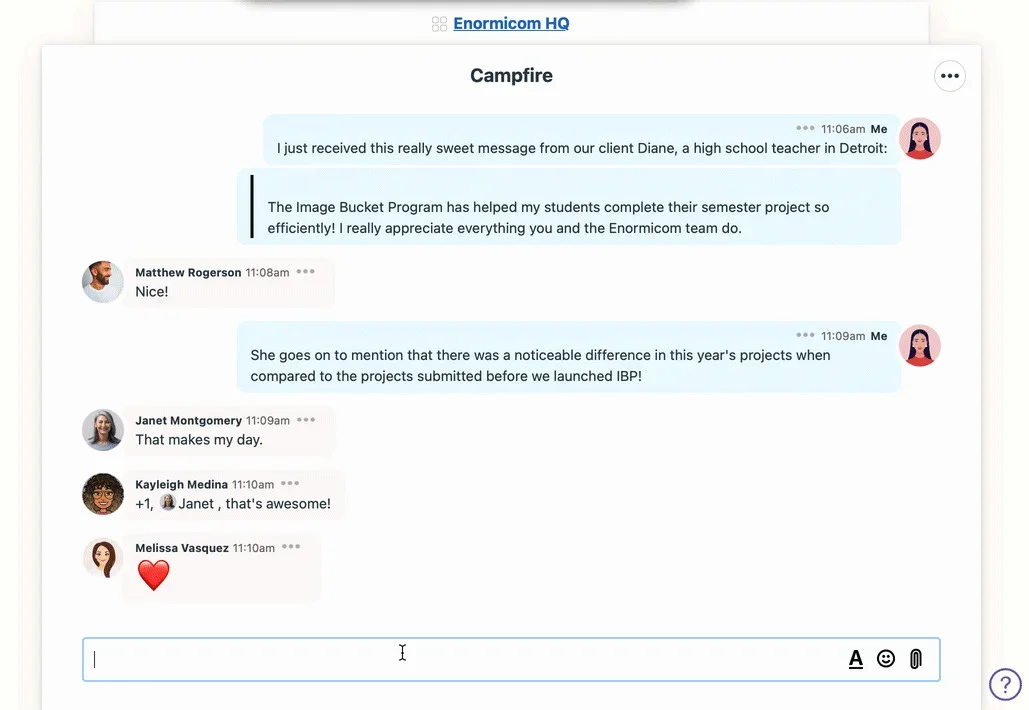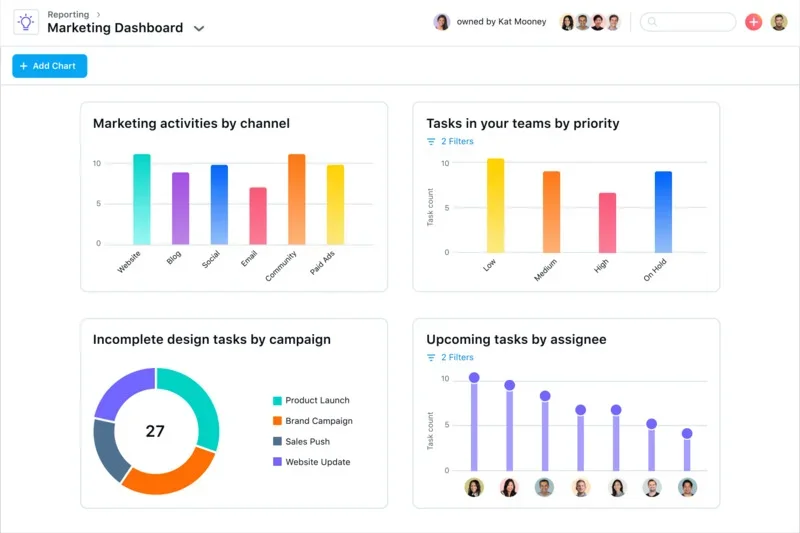The project management software and processes professionals employ in managing projects should assist — not complicate — endeavors, which is one reason Asana and Basecamp have become popular web-based solutions.
But which of these two cloud-based project management applications is better? Both Asana and Basecamp are capable project management solutions and include a variety of features and options. Our comprehensive review compares both tools to help you determine the best project management tool for your business.
Basecamp vs. Asana: Comparison table
| Features | ||
|---|---|---|
| Starting price (billed annually) | ||
| Starting price (billed monthly) | ||
| Free forever plan | ||
| Native time tracking | ||
| File storage | ||
| Integration with third-party services | ||
| 24/7 support | ||
| Star rating |
Basecamp vs. Asana: Pricing
The cost structures of Basecamp and Asana are different and may prove the deciding factor in which platform an organization selects. Basecamp offers two pricing models: Basecamp and Basecamp Pro Unlimited. Asana offers four: Basic, Premium, Business and Enterprise.
Basecamp pricing
Basecamp received a TechRepublic score of 1 out of 5 for pricing.
- Free: 30-day free trial.
- Basecamp: 15 per user per month – ideal for freelancers, startups or smaller teams.
- Basecamp Pro Unlimited: $299 per month, billed annually, or $349 per month, billed monthly.
For more in-depth lists of features and analysis, read our full Basecamp review.
Asana pricing
Asana earned a TechRepublic mark of 2 out of 5 for pricing.
- Personal: Free forever for a team of up to 10 members.
- Starter: $10.99 per user per month billed annually or $13.49 per user per month billed monthly.
- Advanced: $24.99 per user per month billed annually or $30.49 per user per month billed monthly.
- Enterprise: Contact Asana teams for custom quotes.
- Enterprise+: Custom pricing.
To learn more about Asana, check out our full Asana review.
Basecamp vs. Asana: Feature comparison
Basecamp earned an excellent score of 4 out of 5 for features, while Asana scored a near-perfect mark of 4.9 out of 5 in the same category. We arrived at these ratings after testing both platforms to learn about their capabilities and functionalities. In our evaluation, we found that Asana is more feature-rich compared to Basecamp. However, Basecamp makes up for this with its extensive collaboration prowess and ease of use.
Basecamp vs. Asana: Ease of use
Winner: Basecamp
The major factor that gave Basecamp a boost in the industry is that it’s easy to use for teams of all levels. Basecamp is a straightforward tool with a clean and visually appealing user interface that is easy to navigate. It provides a centralized view (Figure A) of the key features you need, including messages, real-time chat, storage, documents, automatic check-ins and more. Users on review sites also applaud Basecamp’s simplicity, as it offers beginners and experts a low learning curve.

Asana’s ease of use is relative — it depends on who uses the tool. Asana is a feature-rich project management software (Figure B) with many advanced capabilities. The tool is generally easy to use when working with basic features, but when dealing with complex projects, you may experience a steep learning curve, and it can quickly get overwhelming.

Basecamp vs. Asana: Integrations
Winner: Asana
While both platforms offer integration with third-party services, Asana ranks higher in this category. Basecamp integrates (Figure C) with tools across various categories, including mobile and desktop apps, time tracking, invoicing and accounting, reporting, charts, planning and developer-only tools.

Asana offers more integration (Figure D) than Basecamp, allowing you to integrate with hundreds of third-party services, including Microsoft Teams, Looker, OneDrive, Loom and more. The choice between Basecamp and Asana will depend on the specific integrations you require and how well each tool fits into your overall workflow and project management needs.

Basecamp vs. Asana: Support
Winner: Tie
Both Basecamp and Asana offer support to their users, but there are some differences in their approach and availability.
Basecamp offers a faster response compared to Asana. They provide 24/7 priority support to their users and aim to respond to customer inquiries within one hour. They also have a help center with extensive documentation and guides that users can refer to for self-help.
Asana’s 24/7 support is limited to enterprise users only; other users can get support from the Asana Forum, Academy, Webinars, Guide, Support and Developer Guide.
Basecamp vs Asana: Collaboration
Winner: Basecamp
Basecamp’s Message Board, Campfire (Figure E), Pings, Activities, scheduling and document and file-sharing features assist teams working independently but collaboratively from different locations. Basecamp collects tiles for accessing message boards, to-dos, files and schedules within each specific project. This also includes a tile within each project titled Campfire, where group chats and other shared information reside.

Asana’s Inbox, task assignment features, scheduling features and file-sharing facility extend the same collaboration capabilities. In Asana, projects are displayed using list or board views, which are accessible from within a user’s My Tasks view. Individual projects are also listed within the user’s Workspace pane in the left-hand navigation menu.
Basecamp vs Asana: Portfolio view
Winner: Asana
Basecamp and Asana have a portfolio view, where key initiatives, workloads and team capacities can be monitored. Both platforms also include a goals view, which permits tracking progress toward project milestones and objectives. The two project management platforms assist in reporting as well.
Asana users compile reports using the solution’s Reporting engine (Figure F). In contrast, Basecamp users leverage the tool’s Activity feature to generate reports, such as for all the latest activity associated with a project, a specific user’s activity, assignments, to-dos and even upcoming dates and deadlines.

Basecamp pros and cons
| Pros | Cons |
|---|---|
| Easy to learn and use | No free plan for business users |
| Extensive collaboration features | Lacks native time tracking |
| Fast and reliable customer service team | Limited advanced features |
| Offers per user per month and organization-wide pricing options |
Asana pros and cons
| Pros | Cons |
|---|---|
| Offers a free forever plan for up to 10 members | Requires some experience to use its advanced features |
| Suitable for managing complex projects | Lacks multiple assignees to the same task capability |
| Task dependencies management | |
| Advanced security options |
Should your organization use Basecamp or Asana?
The better option between Basecamp and Asana depends on your specific needs. Basecamp is big on collaborative features and quality support. The platform is ideal for those working on simple projects or for teams looking for a platform that allows them to collaborate on tasks seamlessly.
Asana is your go-to project management tool if you have complex PM needs and require advanced features to achieve your goals. Large companies with cross-functional teams will also benefit from Asana’s portfolio and resource management capability.
Evaluate your project management needs before selecting either of the two. We also reviewed the best project management tools if Basecamp and Asana don’t meet your needs.
Choose Basecamp if . . .
- You are a freelancer or have a team of freelancers.
- You have small to medium-sized teams.
- Your teams prioritize simplicity and ease of use.
- Your teams need a centralized workspace for collaboration and organization.
Choose Asana if . . .
- You have a budget-conscious team.
- You have large teams or are a part of enterprise-level organizations.
- Your teams work on complex projects with multiple tasks and dependencies.
- Your organization prioritizes integration with other tools and software for seamless workflow management.
Frequently asked questions (FAQs)
What is the difference between Basecamp and Asana?
Basecamp is a project management tool focusing on simplicity and team collaboration, while Asana offers more advanced task management features with customizable workflows and integrations for complex projects.
What is Basecamp best for?
Basecamp is good for small to medium-sized teams seeking a simple, user-friendly platform for project collaboration and communication.
What is Asana best for?
Asana is most suitable for teams needing detailed task management, customizable workflows and extensive integration options for handling complex projects.
Review methodology
We analyzed five key data points to review Basecamp vs. Asana: cost, features, customer support, integrations and ease of use. We also reviewed customer feedback from reputable review sites to learn about current and past users’ experiences with both platforms. Additionally, we tested both platforms to gain hands-on experience with the tools’ features and usabilities, which enabled us to write this review based on personal experience using both software.

